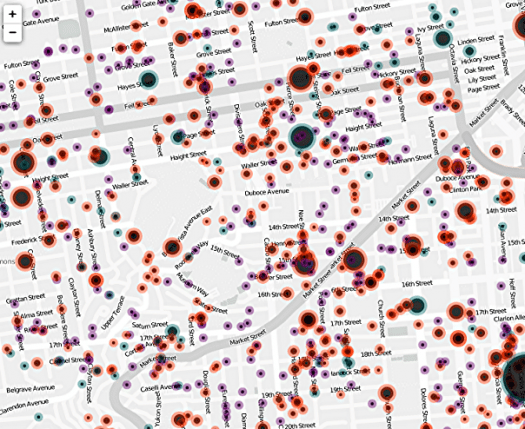
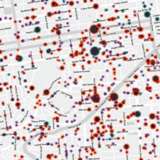
The Anti-Eviction Mapping Project (AMP) was formed to show how speculators target Bay Area communities — and, in our small way, to assist in affecting change. The volunteer AMP collective grew from tangential connections of concerned strangers in April, 2013. Four core members—Erin, Julia, Olivia and myself—have expanded to 12 and counting. We share a deep concern for the growing displacement of our friends and neighbors, yet as individuals, we were initially unsure how we could participate in stopping it.
AMP’s members have varying strengths in data analysis, research, web design, programming and direct action which all complement each other. We hope that our maps and digital storytelling can de-isolate the victims of no-fault eviction and also serve as tools for collective resistance.
San Francisco, like most large cities, is predominantly composed of renters—65 percent. Renters feed the city apparatus as voters, small business owners,


‘Tis the season of miracles.
That’s not a phrase that sits easily with the modern mind. Nevertheless, the stories with which we mark this time of year all contain gestures, unexpected motions and things hoped for — but that are not at all certain or even vaguely possible. The lamp held enough oil for a couple of days at most, but it stays lit for eight – until more can be brought from a distance. A peasant sees the Virgin Mary but, of course, the local bishop doesn’t believe that such a simple person would be visited by Her, but another vision accompanied by long-stemmed red roses convinces him. A poor working family bears a child in circumstances no middle class American can quite grasp, and people think this one will be the liberator of his people. Those are miracles.
Of course, these stories update a deeper and even older human experience when the ancients awaited the sun’s return.


“Give and it shall be given unto you is still the truth about life.”
D.H. Lawrence said that almost a century ago. Now we can read scientific evidence that this statement is true. How much we have or how much we earn does not make us happy. How we spend what we have is what makes us happy and the more that spending connects us to other human beings, the happier we are. Giving – to another person or through a charitable organization – is the deepest connection we can make.
While the conclusions of Happy Money, a book by research academics Elizabeth Dunn and Michael Norton, demonstrate that happiness and giving are closely connected, they also indicate that giving boosts our odds of living longer and healthier. Furthermore, the authors say, when a man in an experimental situation gave more to someone needy,


While growing up an American Catholic, I learned to tune out the Vatican, which had the air of Old World irrelevancy. The pope, I thought, was just the Catholic Church’s version of Queen Elizabeth, some doddering old monarch with no real power. The uncharismatic Pope Paul VI was a case in point, a kind of Millard Fillmore of the papacy. But instead of some dude with a bad 19th century haircut embroiled in states’ rights debates, this was an old Italian guy in a white dress. Same difference. But what did it have to do with my world?
Well, plenty as it turned out, for my boyhood coincided with the implementation of Pope John XXIII’s Vatican II reforms, which did in fact alter my world—in important ways. For a 9-year-old those important changes included permission to wear sneakers and T-shirts into church, the folk mass, no Latin classes — and an interesting lesson in architecture as the new circular churches that began to appear were more like theater in the round vs.
» Read more about: Pope Francis: Is God Actually in the House? »
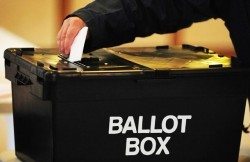

(Note: Ari Berman’s post first appeared on The Nation and is republished with permission.)
In its 2013 decision in Arizona v. The Inter Tribal Council of Arizona, the Supreme Court ruled 7-2 that Arizona’s proof of citizenship law for voter registration violated the 1993 National Voter Registration Act (NVRA).
In 2004, Arizona voters approved Proposition 200, a stringent anti-immigration law that included provisions requiring proof of citizenship to register to vote and government-issued photo ID to cast a ballot. Last year, the US Court of Appeals for the Ninth Circuit blocked the proof of citizenship requirement, which it said violated the NVRA. Under the 1993 act, which drastically expanded voter access by allowing registration at public facilities like the DMV, those using a federal form to register to vote must affirm,


Governor Jerry Brown has included AB 1263, the Medical Interpreters Bill, in a group of bills passed by the California legislature that he vetoed. As Frying Pan News’ Gary Cohn wrote August 20, “Day after day, non-English speaking patients are seeing doctors and nurses throughout California without the aid of medical interpreters, sometimes with tragic results.”
Cohn’s article highlighted stories in which Californians lacking fluency in English received harmful or unintended medical advice, or who were kept in the dark on the medical conditions of loved ones. AB 1263, authored by Assembly Speaker John A. Pérez (D-Los Angeles), would have spent $200,000 to gain access to $270 million in Affordable Care Act funds to create about 7,000 interpreter jobs within 10 years.
The governor vetoed the measure Sunday, commenting, according to the Sacramento Bee, that “California has embarked on an unprecedented expansion to add more than a million people to our Medi-Cal program.
» Read more about: Governor Vetoes Medical Interpreters Bill »
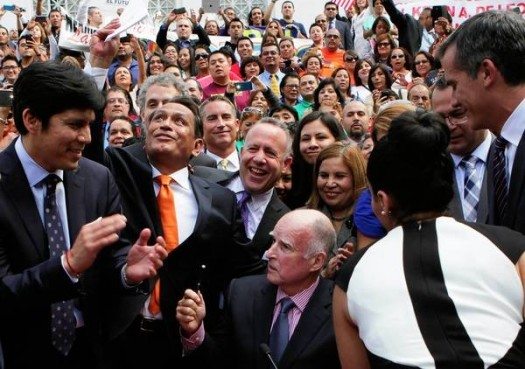

The caption under this front-page photo in Friday’s Los Angeles Times read: “Gov. Jerry Brown, center, is surrounded by cheering officials, from left, state Sen. Kevin de Leon, L.A City Councilman Gil Cedillo, Senate President Pro-Tem Darrell Steinberg and L.A. Mayor Eric Garcetti.”
Missing from that list is the smiling woman right behind Brown. That’s Angelica Salas, executive director of Coalition for Humane Immigrant Rights in Los Angeles (CHIRLA), a key leader of the immigrant rights movement in California and nationwide and a major force behind passage of the bill that Brown was signing. Salas is also missing from the news story that accompanied the photo. The article quoted politicians and law enforcement officials, but none of the activists whose years of work resulted in this new law as well as several other recent legislative victories, including a domestic workers bill of rights and an increase in the state minimum wage to $10 an hour.
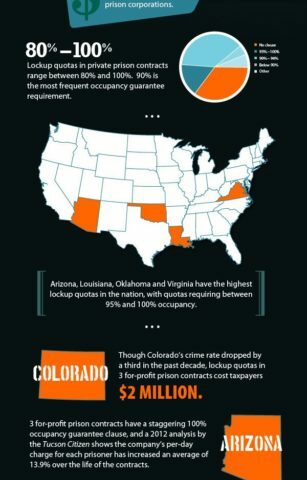
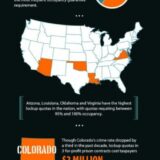
Today In the Public Interest released a report titled Criminal: How Lockup Quotas and “Low-Crime Taxes” Guarantee Profits for Private Prison Corporations.
The study documents the shocking prevalence of contract language between private prison companies and state and local governments that guarantee prison occupancy rates, which can accurately be described as “lockup quotas.”
If the quota is not met due to lower crime rates and a falling prison population, taxpayers are forced to pay for empty beds in what essentially amounts to a “low-crime tax” on communities.
Lockup quotas can have broad negative implications beyond obvious financial concerns and should be prohibited in any private prison contract. See report infographic below and the report here.
The more people are aware of lockup quotas the more we as a community are empowered to prevent this type of predatory language from existing in private prison contracts —
» Read more about: Stop Prison Inc. from Pushing Lockup Quotas »


(Note: Katha Pollitt’s feature first appeared in The Nation and is republished with permission.)
Here’s a little window into poverty, American- style. According to a Yale University study published in August in Pediatrics magazine, almost 30 percent of low-income women with children in diapers can’t afford an adequate supply of them, with Hispanic women and grandmothers raising grandchildren the most likely to be in need. Some women are forced to make one or two nappies last the whole day, emptying them out and putting them back on the baby. Based on a survey of almost 900 low-income women in and around New Haven, Connecticut, investigators found the lack of diapers—such a simple thing—had profound and complex effects. The risks to children’s health are obvious: rashes, urinary tract infections, painful chafing. (If a mom is too poor to afford diapers, she probably can’t afford diaper cream or wipes or baby powder,
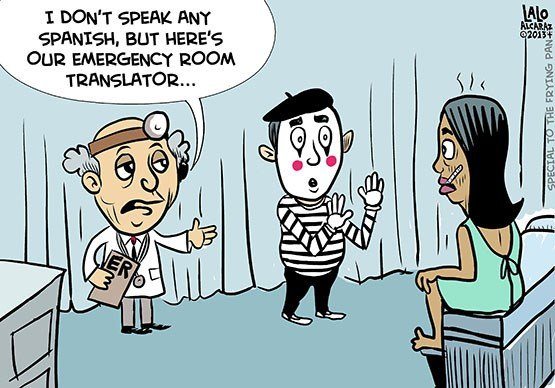

Maria Guevara had been trying to get pregnant for three years when she saw a doctor at Los Angeles County General hospital in 2008. She was understandably thrilled, then, to learn she was indeed three months pregnant at the time of her visit. As Guevara later recalled, when the doctor asked her in English if she wanted to keep the baby, “without hesitation I replied ‘yes’ to his question. Before leaving the hospital, the doctor prescribed me medication that I thought was prenatal care. That lack of communication between the doctor and me has changed my life forever.”
Guevara took the prescribed medication, and experienced violent pain and bleeding. She returned to the hospital, where another doctor told her the bleeding was the result of a miscarriage.
“My baby was dead. The medication the initial doctor prescribed to me was not prenatal care but medication to induce an abortion,” she told a press conference in April at the University of California Davis Medical Center in Sacramento.
» Read more about: Interpreter Bill Would Help Save Lives Lost in Translation »


As Labor Day approaches, here’s a question that many opponents of immigration reform don’t want to answer honestly: Can you be for the middle class and against comprehensive immigration reform? The answer is no — a fact that creates all kinds of problems for those lobbying to stop legislation that would create a path to citizenship for millions of undocumented immigrants.
Foes of immigration reform like to position themselves as true-blue patriots acting in the best interests of the country. But it’s hard to square that image with opposition to legislation that, more than any other single act, could help rebuild the nation’s middle class.
It’s obvious to most people that immigration reform would improve economic conditions for undocumented immigrants. After all, while most immigrants come here in search of a better life, their legal status often relegates them to low-wage jobs with few if any benefits and unsafe workplace conditions.
» Read more about: Immigration Reform Debate: Facts v. Bad-Faith Arguments »
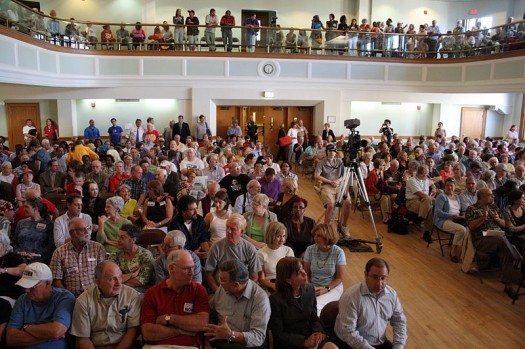

The future of immigration reform could well to be decided in the next three weeks. And this will occur not in the halls of Congress but in Congressional Town Hall meetings across the nation. Anti-immigrant activists are hoping for a replay of the Tea Party’s successful August 2009 attacks on health care reform; by triggering loud public confrontations with Congressmembers in normally placid Town Hall meetings, conservative activists led the media to wrongly conclude that reform lacked public support. But in 2013, progressives are prepared. Immigrant rights activists believe they can use the Town Halls to expose the strength of their support and propel immigration reform to passage. Considering that both sides are prepared and the key element of surprise is lacking, whose activist strategies will prevail?
As even President Obama acknowledges, the passage of immigration reform comes down to whether Speaker John Boehner will allow a House vote. A majority of House members would support the Senate bill if given the chance,
» Read more about: Path to Citizenship Passes Through Town Hall Meetings »
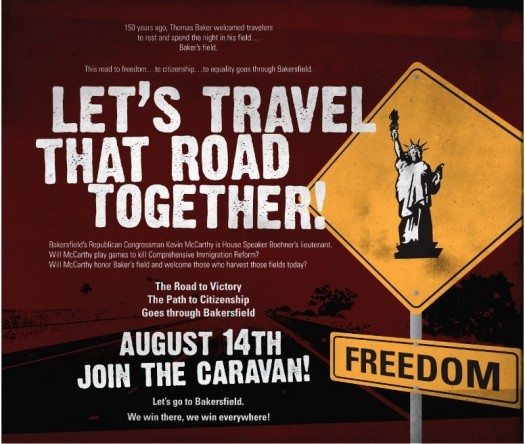

(Editor’s Note: On August 14, hundreds of cars from all corners of the state will travel in caravans to Bakersfield, California, to urge House Majority Whip Kevin McCarthy [R-Bakersfield] to support and advocate for a vote on immigration reform with a path to citizenship.)
Greyhound bus drivers took the initiative to share with their employer why comprehensive immigration reform is important for the community and posed a challenge to the company: Greyhound Bus Line could either keep up with the change or stay behind. The company recognized the importance of immigrants to their business and decided to embrace diversity through their full support of immigration reform.
A Greyhound van will be participating in the Citizenship Caravan to Bakersfield, August 14. Bus Drivers Leonard Weaver and Sindy Vasquez – members of the Amalgamated Transit Union, ATU Local 1700 – championed the immigration reform campaign at their workplace and are looking forward to the caravan.
» Read more about: Join the Immigration-Reform Caravan to Bakersfield! »


(Dave Zirin writes about sports and society for the Nation, where this post first appeared. Republished with permission.)
Sometimes it’s all just too damn much. First came word this week that the famed Coney Island statue of Jackie Robinson, standing alongside Pee Wee Reese as sporting symbols of racial progress, had been defaced, with “die n***ers,” “f*ck Jackie Robinson and all n***ers,” and “Heil Hitler” scrawled across it. It’s quite the capstone to a summer that started with the sweetly hopeful biopic, 42, about Robinson’s early career and post-racial promise. There is no doubt if Robinson still walked among us, he wouldn’t be shocked at the vandalism of his statue. He’d grit his teeth and set to cleaning it with his bare hands as a vein throbbed dangerously on his temple. This is the world—and the country—Jackie Robinson knew all too well.
» Read more about: Jackie Robinson, Trayvon Martin and the Ebony Boycott »
Imagine a Mexican father telling his child that he’s leaving for America. He probably wouldn’t spend a lot of time explaining the complicated economic and political relationship between Mexico and the U.S., nor would he spend a lot of time explaining how difficult and dangerous the journey to el norte would be.
It would be a simple explanation, in all likelihood: “I have to go north to find work to earn money for my family.”
The children’s story Pancho Rabbit and the Coyote by Duncan Tonatiuh starts with a statement much like that. Like so many Mexican workers, Pancho Rabbit’s father decides go to north because of lack of work at home – “The rains did not come and the crops would not grow.”
Papá Rabbit, along with companions including Señor Ram and Señor Rooster, leave at the beginning of the story. The story is told from the point of view of Papá Rabbit’s family,

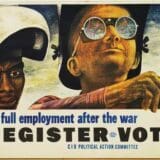
It’s not coincidental that at this very moment both the labor and racial justice movements stand at a crossroads in our nation’s consciousness. The people who fight to undo worker’s rights and assault unions are often the very same folks who craft laws and policies that allowed Trayvon Martin’s killer to walk free, that disenfranchise black voters and expand the use of racial profiling. Moreover, the public rhetoric of post-racialism is closely tied to the false promise of rampant corporate profiteering that casts the labor movement as an irrelevant “special interest.”
In 2013 the landscape of the national labor movement could charitably be described as “receding.” Last year the U.S. Bureau of Labor Statistics reported a national union membership rate of 11.3 percent — down from 11.8 percent in 2011.The ever-declining number of union members in 2012 was 14.4 million, while in 1983, the first year for which comparable union data are available,
» Read more about: At a Crossroads: Labor Faces the Future »
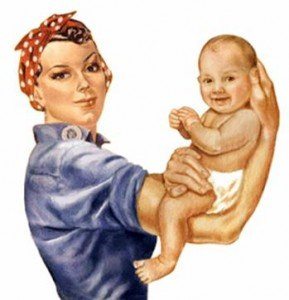

If 2012 was the year of the woman, 2013 is the year of the working mom. And that’s why I’m headed to California. Last week, House Minority Leader Nancy Pelosi along with Congresswomen Rosa DeLauro, Doris Matsui and others announced a new economic agenda for women and families, built on three key pillars for driving women’s economic advancement: 1) equal pay for equal work, 2) work-family balance, including paid sick leave and a livable minimum wage, and 3) access to quality, affordable child care.
As many have noted, these priorities are not new ideas. Women have been advocating for decades for these policies, because they work, they are fair and they are critical to the success of our nation. What is new is the momentum behind putting these practical solutions to work so that we can kick-start an economy that continues to languish and restore the American promise for our children — that their futures should be brighter,
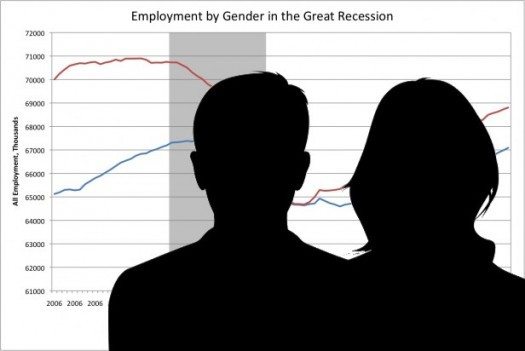
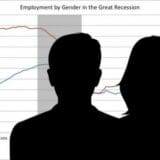
How are men doing in our anemic economic recovery? David Brooks, after discussing his favorite Western movie, argues in his latest column, Men on the Threshold, that men are “unable to cross the threshold into the new economy.” Though he’d probably argue that he’s talking about generational changes, he focuses on a few data points from the current recession, including that “all the private sector jobs lost by women during the Great Recession have been recaptured, but men still have a long way to go.”
Is he right? And what are some facts we can put on the current recovery when it comes to men versus women?
Total Employment
Men had a harder crash during the recession, but a much better recovery, when compared with women.
Indeed, during the first two years of the recovery expert analysis was focused on a situation that was completely reversed from Brooks’


The battle over immigration reform is often about economic fear — fear that immigrants are hurting the economy for native born Americans. But that fear is based on several economic myths:
Myth One: Immigration reform will strain already overburdened government safety net programs like Social Security and Medicare.
Wrong.
The nonpartisan Congressional Budget Office finds that immigration reform will actually reduce the budget deficit by hundreds of billions of dollars.
Why is that? Because while they seek citizenship, undocumented workers will be required to pay into Social Security and Medicare even though they won’t be eligible for them.
They’re also younger on average than the typical worker, so even when they’re citizens they’ll be paying into Social Security and Medicare far longer.
Myth Two: New immigrants take away jobs from native-born Americans.
Wrong again.
» Read more about: Immigration Myths: Three Wrongs Don’t Make a Right »


Wednesday’s Supreme Court rulings on same-sex marriage represented a major victory in the battle for social justice. But the Court stopped short of proclaiming same-sex marriage a basic right. It left it to the states to determine whether gay Americans have the same right to marry as their straight counterparts.
This is the same logic — states’ rights — that allowed the Court this week to weaken the Voting Rights Act of 1965, essentially giving states permission to discriminate against Blacks and Latinos in gerrymandering electoral districts and erecting obstacles to voting. Soon, we’re likely to see a number of Republican-controlled states, including Texas, redraw legislative boundaries to make it harder for minority candidates and white liberal candidates backed by minority voters (such as Texas State Sen. Wendy Davis, who courageously waged a filibuster this week to protect women’s reproductive rights) to win public office and to change state laws to make it harder for people to vote.
» Read more about: What the Supreme Court Didn’t Do for Marriage Equality »